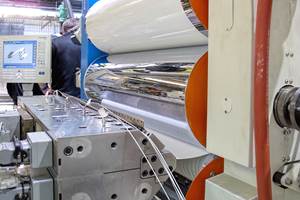Telltale Signs of Screw Wear
Determining the cause of wear is the first step in eliminating it.
Screw and barrel wear can be one of the most expensive operating costs in an extrusion process. But it can be reduced or even eliminated if you understand the cause. Wear of this type is caused by several things. Assuming the screw and barrel materials are compatible—there are many fully developed and tested materials available—let’s focus on other possible causes of screw wear, and then talk about how you can distinguish one type from the other.
In previous columns I have noted that one of the most serious wear effects is caused by wedging, which is an unbalanced radial pressure in the screw that aggressively forces the screw against the opposite barrel wall. Wedging occurs when the melting rate is exceeded to such an extent that the screw essentially gets momentarily plugged with solid polymer. A high pressure develops on one side of the barrel, with much lower pressure on the other side. This is largely a screw-design issue and generally cannot be corrected by changing operating conditions, such as simply increasing the barrel temperatures. Slowing the rpm is about the only effective measure, and that is always undesirable due to the lost output.
A second cause of wear is caused by abrasive fillers that get caught between the flight O.D. and the barrel wall. These particles—even though they are considered much softer than the flight and barrel material—can erode the screw flight and barrel, even at relatively low pressures. It’s like sand washing over the rocks on a beach.
The third type of wear is related to barrel alignment. When the screw has to rotate in a cylindrical space that is not straight, it has to bend with each revolution. The bending force is enormous and again aggressively forces the barrel and screw flights together under great pressure, causing a crushing of the metal as well as a tearing away or galling of the two materials.
Since the screw is contained in the closed environment of the barrel, it’s usually not obvious which or how many of these wear mechanisms is taking place. But I have found over the years that there are telltale signs of the cause if you examine the worn screw flights.
If you have a burr on the trailing side of the flight, wedging is most likely the cause. That occurs from a combination of the high compressive force and the angular motion of the flight relative to the barrel wall during rotation. Essentially, the flight surface is torn off the back of the flight. This will occur almost exclusively in the compression or barrier section of the screw.
Mineral fillers often contain hard particles. However even relatively soft materials can cause a degree of screw wear through an extended combination of particle fracture, removal of lubrication, and impact. The same holds true of virtually any type of recycled material. Wear caused by abrasion will tend to reveal itself by a polishing or rounding of the flight corners on the pushing side of the flight surface, eroding the base screw material
Misalignment creates a combination of forces: One is similar to the wedging, but in addition there is also an enormous pressure on the flight as the screw is forced to bend to follow the barrel bore. This results in a tearing and a crushing action that produces a burr on both sides of the flight. This can happen at any area on the screw, depending on the barrel support(s) and alignment with the reducer.
Determination of the cause of the wear is the first step to eliminating it. Once the cause is determined, corrective actions are pretty clear. Occasionally there can be two simultaneous causes—such as wedging and alignment or abrasive wear that masks the other two—but that is pretty rare and does not negate this analysis.
ABOUT THE AUTHOR: Jim Frankland is a mechanical engineer who has been involved in all types of extrusion processing for more than 40 years. He is now president of Frankland Plastics Consulting, LLC. Contact jim.frankland@comcast.net or (724)651-9196.
Related Content
Roll Cooling: Understand the Three Heat-Transfer Processes
Designing cooling rolls is complex, tedious and requires a lot of inputs. Getting it wrong may have a dramatic impact on productivity.
Read MoreCooling the Feed Throat and Screw: How Much Water Do You Need?
It’s one of the biggest quandaries in extrusion, as there is little or nothing published to give operators some guidance. So let’s try to shed some light on this trial-and-error process.
Read MoreWhy Compression Ratio is Important
Compression ratios have been pretty much standardized over the years, based on what has typically worked before. But there are quite a few variables that must be considered in order to get the optimum performance from your screw.
Read MoreTroubleshooting Screw and Barrel Wear in Extrusion
Extruder screws and barrels will wear over time. If you are seeing a reduction in specific rate and higher discharge temperatures, wear is the likely culprit.
Read MoreRead Next
Why (and What) You Need to Dry
Other than polyolefins, almost every other polymer exhibits some level of polarity and therefore can absorb a certain amount of moisture from the atmosphere. Here’s a look at some of these materials, and what needs to be done to dry them.
Read MoreTroubleshooting Screw and Barrel Wear in Extrusion
Extruder screws and barrels will wear over time. If you are seeing a reduction in specific rate and higher discharge temperatures, wear is the likely culprit.
Read More.jpg;width=70;height=70;mode=crop)









